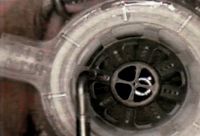Article
Corneal template enables and enhances CK
A new corneal template (OptiPoint, Refractec) for conductive keratoplasty ([CK]; ViewPoint CK, Refractec) was designed to address existing challenges of the procedure to make CK easier to learn and perform while improving the consistency of the results. Those benefits along with good refractive and vision outcomes have been achieved in clinical use.

Key Points

"The template appears to fulfill its design goals for standardizing spot placement and application of pressure so that it improves the consistency of outcomes between surgeons and should speed the CK learning curve for new surgeons," said Dr. McDonald, in private practice with Ophthalmic Consultants of Long Island, Lynbrook, NY, and clinical professor of ophthalmology, Tulane University Health Science Center, New Orleans.
"Clinical findings to date show that its use results in good visual acuity with minimal to no induced cylinder as has been achieved using a reduced-compression technique (LightTouch, Refractec) and indicate a benefit for less early regression," she said. "However, ongoing follow-up will determine if that latter effect is maintained."
"Most patients, but not all, lose sight briefly because of the vacuum," she said.
Discussing the use of the template by five experienced CK surgeons who performed more than 50 procedures with it between September 2006 and March 2007, Dr. McDonald noted that their anecdotal impressions were that the device provided greater consistency across treatments and treatment spots to help standardize the procedure.

Data from 41 procedures performed by Daniel S. Durrie, MD, of Overland Park, KS, and Henry L. Milne, MD, of Columbia SC (22 and 19 eyes, respectively), further highlighted the value of the template for improving treatment consistency. Those CK treatments were performed using a pattern of 16 spots at 7 and 8-mm optical zones. The results showed very tight agreement of the mean effect measured in diopters at 1, 3, and 6 months (Dr. Durrie, 1.88, 1.54, and 1.39 D, respectively; Dr. Milne, 1.83, 1.54, and 1.38 D, respectively).
"Previous studies demonstrate both of these surgeons achieve excellent results with CK, but there were differences between them," Dr. McDonald said. "With use of the template, there was remarkable agreement."
Dr. McDonald also presented data to compare the results achieved by Drs. Durrie and Milne using the template against those they achieved using the reduced-compression technique alone and with the conventional CK technique in the FDA presbyopia trial. Data showed that the effect achieved with the template was slightly less than that associated with the reduced-compression technique and more similar to the results achieved in the presbyopia study. The template-guided technique, however, retained the advantage of the reduced-compression technique for minimizing induced cylinder.
In the series treated by Drs. Durrie and Milne with the template, 59% of eyes had no change in cylinder, and 83% of eyes had less than 0.75 D change. Induced cylinder exceeded 1 D in only 3% of eyes.
Newsletter
Don’t miss out—get Ophthalmology Times updates on the latest clinical advancements and expert interviews, straight to your inbox.




